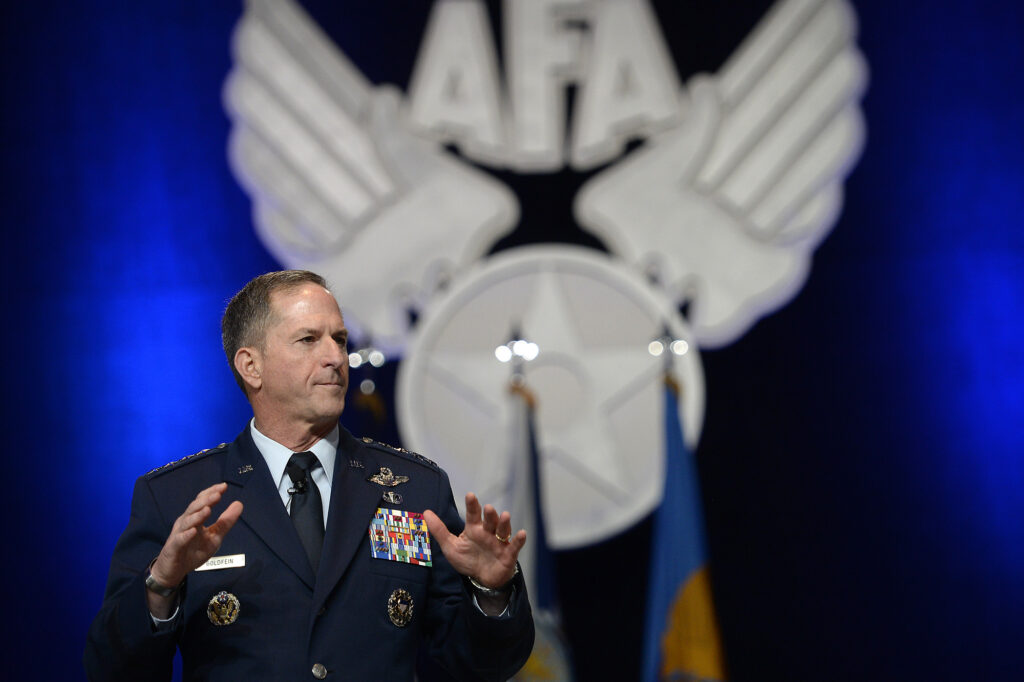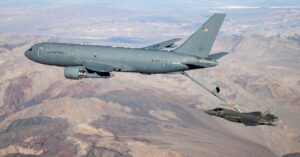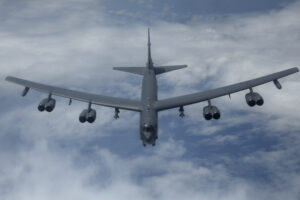
Gen. David Goldfein
WASHINGTON: Senior defense leaders have seen evidence that US adversaries are using the COVID-19 coronavirus outbreak to try and disrupt US society with disinformation campaigns, Air Force Chief of Staff Gen. David Goldfein confirmed today.
Goldfein wouldn’t provide specifics or name names, citing classification concerns. But he spoke in response to a reporter’s question about malicious activity by China, Russia and ISIS/Al Qaeda to exploit the pandemic as a means to harm military operations and/or society.
“We have seen those, but I’ll be a little careful on how I describe any details with you in terms of breaching the classified versus the unclassified,” he said. “But we are seeing in the information spaces especially … we are seeing those that are trying to take advantage of this situation,” Goldfein said in a wide-ranging discussion this morning sponsored by the Mitchell Institute.
“If there was ever one time where … the nations, the international community, were to come together and perhaps put aside our differences to be able to attack this global threat, it’s right now,” he added. “And every day that goes by where we are not combining our talent to be able to produce a vaccine, and produce a global solution to this global challenge, is a shame.”
There have been widespread public reports about official Chinese efforts to paint the coronavirus outbreak as the fault of the US Army and then suggesting that the outbreak originated in Italy rather than in China’s Wuhan province. Indeed, as CNN first reported on March 13, the State Department summoned the Chinese Cui Tiankai to tell Beijing to knock it off. For his part, President Trump has very publicly called the COVD-19 the Chinese virus and made clear his irritation with Chinese claims the US Army was somehow involved with the viral outbreak.
Foreign hackers have tried to breach US Health and Human Services networks, and use fears about the virus to infiltrate computers for financial gain. The cybersecurity firm FireEye reported on March 25 that Chinese hacker group APT41, a group affiliated with the Chinese government that also seems to work for its own members financial gain, began waging a cyber intrusion campaign across multiple countries and multiple economic and government sectors in January as the Wuhan outbreak emerged. FireEye called it “one of the broadest campaigns by a Chinese cyber espionage actor we have observed in recent years.”
Further, multiple disinformation campaigns to sow disorder among US citizens have erupted across social media platforms, including, as ABC reported March 17, the spread via text of a false warning that Washington intended to shut down all public services and impose a harsh quarantine.
Defense Secretary Mark Esper warned staff that increased telework comes with increased cybersecurity risks in a town hall meeting on March 24, although he did not go into detail about specific attacks.
On the flip side, Goldfein said that he and his counterparts in allied countries have been conferring “every day” to work out how they can coordinate their efforts to support national and regional responses to the pandemic.
“I’m in an ongoing dialogue with my international air chiefs, that was initiated by the chief of staff of the Italian Air Force when he shared what the Italian Air Force is looking at as they approach this pandemic. And we’re in a daily conversation now about how do we approach this as international air chiefs together.”
For example, Goldfein said, one of the issues being discussed is how the allied air forces might utilize or modify air mobility platforms based on air flow inside the aircraft. Whether the air flow inside is from back to front as it is within a C-17 or front to back as it is in KC-46 and KC-10 tanker-transports, he said, obviously matters for the health of the crew if the aircraft are to carry coronavirus patients.

A KC-46 refuels an F-35
As for affects on the Air Force itself from the growing crisis, Goldfein said that “it’s not business as usual, but business as required.” While he admitted that the situation is affecting readiness, he said he has launched an effort with MAJCOM commanders to “identify mission essential tasks,” put resources to those tasks first and adjust operations as necessary.
“And those things that don’t fall into the essential task list, we either have to stop doing or significantly curtail,” he said. “We’re going to be going through that review today … and we’re going to continue to look at this everyday.”
Asked specifically about Pacific Air Force (PACAF) operations that have recently included a continuous bomber presence to send a signal to Beijing about its aggressive activities in the region, Goldfein suggested — but didn’t say outright — that the service is moving to reduce that ops tempo. Of course, we may be increasing the tempo, but we just don’t know… Rejiggering Air Force operations in the Pacific comes as the Navy is struggling to maintain its presence in the volatile region. Coronavirus aboard ship has forced the USS Theodore Roosevelt aircraft carrier to dock in Guam and. The only other carrier in the Pacific, the USS Ronald Reagan, is currently undergoing refit and repair in Japan there could be a good argument for regularly deploying more bombers more often.
“We are absolutely adjusting our presence when it comes to bombers,” he said, “but I can’t tell you what that looks like because that would make me operationally predictable.”

An Air Force B-52H Stratofortress bomber fly over the Pacific Ocean.
In response to my questions about the potential impacts of the latest serious problem — leaking fuel lines — to afflict the long-troubled KC-46 tanker, Goldfein said he is not expecting it to affect delivery and waxed hopeful that fixes to all the current deficiencies bedeviling the Boeing aircraft would be fixed soon.
“I don’t get concerned immediately when they tell me that our testers have found a deficiency. The question is how quickly, then, we can determine what the fix is and get after it,” he said. “On this one, as it has been explained to me, it’s not a safety issue at all. It’s a deficiency in terms of some leakage in the system during refueling operations.”
The Air Force announced on Monday that it had deemed the fuel line problem a Category 1 deficiency, which indicates a serious problem. This is the fifth Category 1 deficiency finding the supposedly low-risk KC-46 program has racked up. And it comes as Boeing and the Air Force are in final negotiations about a fix to another long-standing problem: the Remote Visual System (RVS) that allows operators to safely position the boom during re-fueling operations.
“I’m not hearing anything right now that indicates to me it’s going to cause a delay,” Goldfein said. “But it’s probably a little bit early for me to forecast that based on the fact that the engineers are right now swarming on that to take a look.”
Goldfein said that while he has not personally briefed Congress — which has expressed concerns about the potential gap between the KC-46 becoming operational and Air Force plans to retire older tankers — but that the service is keeping Congress abreast of the program.
“As you might imagine as we go forward we’ve been having a dialogue with the key stakeholders in Congress that are deeply concerned about this weapon system. And hey, let’s also acknowledge, this has a long, sort of tortured history,” he said. “The good news for me is that I don’t see anything right now that’s by any means unsolvable.”
Navy jet trainer fleet operations remain paused after engine mishap
One week after the incident, a Navy spokesperson says the service is continuing to assess the fleet’s ability to safely resume flight.


























